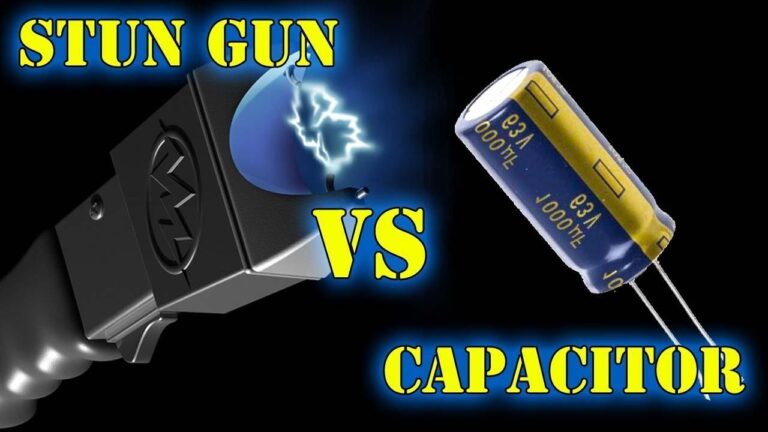Table of Contents
- Understanding the Role of Capacitors in Energy Storage for Stun Gun Circuits
- Analyzing Capacitor Types and Their Impact on Stun Gun Performance
- Optimizing Capacitor Selection for Enhanced Stun Gun Efficiency
- Maintenance Tips for Prolonging Capacitor Life in Stun Gun Devices
- The Way Forward
Understanding the Role of Capacitors in Energy Storage for Stun Gun Circuits
At the heart of a stun gun’s power lies the capacitor, a critical component responsible for rapidly storing and releasing electrical energy. Unlike batteries, which provide a steady current, capacitors accumulate charge over a short period and then discharge it in a sudden, high-voltage burst essential for delivering the disabling shock. This ability to quickly amass and release energy makes capacitors uniquely suited for stun gun circuits, as they ensure the device can deliver powerful pulses in rapid succession without a noticeable delay.
Key functionalities of capacitors in stun gun circuitry include:
- Energy Storage: Capacitors store electrical energy from the battery with minimal losses.
- Voltage Boosting: By charging to a high voltage, they facilitate generation of the intense electric shock necessary to momentarily incapacitate a target.
- Pulse Delivery: Capacitors release stored energy in quick pulses, which are more effective than continuous currents in stun technology.
- Circuit Protection: They help regulate the flow of energy, protecting delicate electronic components from sudden surges.
Analyzing Capacitor Types and Their Impact on Stun Gun Performance
When it comes to the heart of a stun gun’s electrical system, the choice of capacitor is crucial. Different capacitor types-such as electrolytic, ceramic, and film capacitors-each bring unique characteristics that affect the device’s charge storage and discharge capabilities. Electrolytic capacitors are often favored for their high capacitance values, enabling them to store substantial energy for delivering powerful shocks. However, their larger size and slower charge times can influence the stun gun’s weight and recharge speed. In contrast, ceramic capacitors provide faster charge and discharge cycles with smaller form factors but typically hold lower energy, impacting the intensity of the shock.
Understanding these trade-offs allows manufacturers to tailor stun gun performance to specific needs. Key factors impacted by capacitor selection include:
- Voltage stability: Ensuring consistent shock output under varying battery levels.
- Discharge duration: Length of the electrical pulse, crucial for effectiveness and safety.
- Device longevity: Capacitor durability under repetitive charging cycles.
By evaluating these aspects, designers optimize stun guns for both power and reliability, balancing capacitor features to meet operational demands.
Optimizing Capacitor Selection for Enhanced Stun Gun Efficiency
Selecting the right capacitor for a stun gun circuit is pivotal in achieving optimal shock delivery and operational efficiency. Capacitors function as energy reservoirs; they accumulate and release electrical charge rapidly, which directly impacts the stun gun’s performance. Choosing a capacitor with the appropriate capacitance and voltage rating ensures not only maximum energy storage but also reliability under high-stress conditions. For stun guns, electrolytic capacitors are often favored due to their high capacitance per volume, yet designers must also consider equivalent series resistance (ESR) to minimize energy loss during discharge.
Beyond basic specifications, other factors refine the selection process. Key attributes include:
- Charge and discharge cycles: Capacitors must withstand rapid and repeated charge cycles without significant degradation.
- Temperature stability: Consistent performance under varying thermal conditions is crucial for reliability.
- Physical size and form factor: Compactness enhances portability and ergonomic design of the stun gun.
Maintenance Tips for Prolonging Capacitor Life in Stun Gun Devices
To ensure the longevity of capacitors in stun gun devices, regularly inspect for physical damage such as bulging, cracks, or leaks. Capacitors subjected to frequent high-voltage discharges can degrade faster; therefore, maintaining a stable operating environment with minimal temperature fluctuations is essential. Always store stun guns in a cool, dry place away from direct sunlight and excessive moisture, as these conditions can accelerate capacitor wear. Additionally, avoid exposing the device to rapid power cycling-turning it on and off repeatedly in short intervals-as this places undue stress on the capacitors, potentially shortening their lifespan.
Routine cleaning of the device’s internal components, including capacitor terminals, also plays a vital role in sustaining optimal performance. Dust and corrosion buildup can impede connectivity and lead to inefficient charging cycles. When performing any maintenance tasks, make sure to discharge the capacitor safely before handling to prevent electrical shock or damage. Incorporating the following practices can significantly prolong capacitor health:
- Use a multimeter to check capacitor capacitance and ESR periodically
- Replace capacitors showing signs of degradation before failure occurs
- Ensure solder joints are solid and corrosion-free to maintain proper electrical contact
The Way Forward
In summary, capacitors are at the heart of stun gun circuits, efficiently storing and releasing electrical energy to deliver those rapid, high-voltage pulses that make these devices effective and reliable. Understanding how capacitors function within these systems not only sheds light on the underlying technology but also highlights the importance of precise component selection and circuit design. Whether you’re a tech enthusiast or simply curious about the science behind personal defense tools, appreciating the role of capacitors offers valuable insights into the powerful yet sophisticated world of stun gun electronics. Stay tuned for more deep dives into the components that energize our everyday gadgets!Check Our Other Blogs
- StunGun – Your Trusted Source for Stun Guns, Laws, and Self-Defense Tips
- PepperSprayLaws – Your Trusted Resource for Pepper Spray Information
- StunGunLaws – Your Trusted Guide to Stun Gun Legality and Safety





